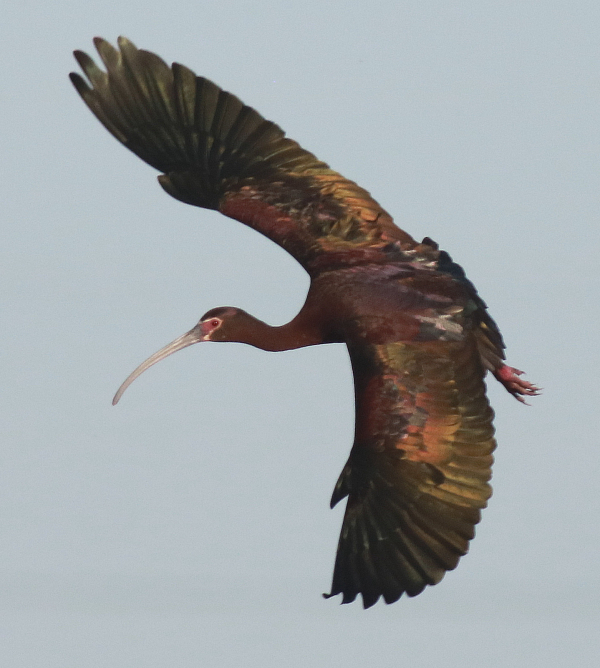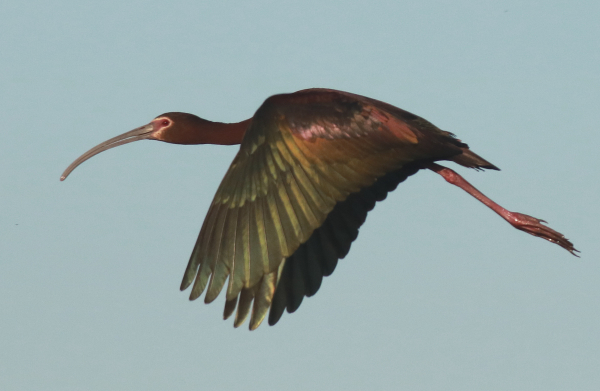
Fighting a strong wind from the west, this White-faced Ibis flashed downward as it landed, providing a nice photo opportunity as the setting sun illuminated some of its iridescent plumage.

Ibis are not common birds in North Dakota, but it appears the McKenzie area is becoming a stronghold for the species – at least this year.
|
Talk about Euphoria Thursday, visiting two favorite locations with very different habitats and bird communities paid big dividends and provided grand smiles. Starting at Melody’s Grove in the morning, just a couple hundred yards southeast of home, an intense northwest wind didn’t bode well for migrants, but I was pleasantly surprised by mostly male Orchard Orioles in the grove; the first warbler was a Mourning Warbler that upped the potential for other exciting species. Most warblers were female American Redstarts, along with a female Blackpoll, and a few male Yellow Warblers.
There were some Warbling Vireos, and eventually a few “first of season” Red-eyed Vireos foraged by. House Wrens were active along with Eastern and Western Kingbirds and lots of Least Flycatchers. I also spied a tantalizing part of a Yellow-breasted Chat – the belly where bright yellow meets the white underbelly. The wonderful assortment of songbirds and flycatchers passed by my position on the edge of a sheltered site on the lee side of the grove with flowering chokecherries and young ash trees. I managed a few photos in the pretty morning light, and hoped this was the first trickle of the next migration push by neotropical songbirds.
McKenzie 5
That afternoon I hightailed it for Bismarck, completed my big city errands quickly and took off for McKenzie Slough for my fifth visit in as many weeks. Despite the super strong wind during my drive, evening seemed to be steadily lulling it into an ever-lower velocity. Certainly, the birds were very active, with acrobatic Franklin’s Gulls, Black Terns, and Common Terns catching flying insects and some that hit the water. The water was lively with pairs of Eared Grebes, Western Grebes, displaying Ruddy Ducks, Northern Shovelers, Gadwalls, Mallards, Blue-winged Teal, Lesser Scaup, Giant Canada Geese, and a few Wilson’s Phalaropes. The cattails were alive with calling and displaying Yellow-headed and Red-winged Blackbirds, a couple American Bitterns, a few Song Sparrows, and overhead, four species of swallows – Cliff, Bank, Barn, and Tree Swallows.
The highlights among that wonderful list of birds, were the scattered White-faced Ibis that flew up from the cattails as my vehicle passed slowly along the road that bisects the expansive wetlands. With the light and wind coming from the west, almost all ibis flew up from the east side of the road, and some of the ibis flew toward me rather than away. As these individuals flew into the wind, they made slow progress, allowing me to take a series of photos as they pressed forward or re-landed. The ibis’s rufous plumage was transformed by the sun as iridescent feathers literally flashed gold, bronze, green-gold, and pink hues. I must admit the ibis will bring me back as often as possible, although each visit to McKenzie has featured different “birds of honor.”
I had so much fun photographing the Franklin’s Gulls, terns, and ibis in flight that only the waning sun could make me leave. Even so, one more bird would catch my attention – a Wilson’s Snipe was standing by the side of the road; how could I resist? I made a half circle around the snipe to get into a better position. As soon as I stopped the snipe began calling, and a second snipe answered from behind me. Apparently I had pulled in between the two snipe, and as a result, the first bird began walking toward me, probably intent to get past me toward the other snipe. In the process, it provided some nice photos before I hit the highway for home.
Nesting Waterbirds
Two miles south of my office, a Western Grebe nesting colony was initiated simultaneously last Monday morning – early it seems – along with one Pied-billed Grebe nesting right in the middle of the Westies. The nesting colony was established on a relatively small marshy extension of a big lake where I can’t remember seeing Western Grebes before. A week later, 24 nests were active, yet the location doesn’t draw much attention, even though it is adjacent to a paved highway.
I also found a lone nesting Pied-billed about five miles south. And a trio of American Coot pairs is incubating clutches on nests just ¾ of a mile south of home. I photographed a few of these nesting birds Wednesday morning during a nice drive and share the photos and information in this week’s Bird Photography article at the end of this issue of The Birding Wire.
Hawk, Eagle, and Owl Nesting Updates
For the first time since she began incubating, I saw the female Ferruginous Hawk standing on the rim of her nest, probably overlooking young downy nestlings, along with her mate Friday evening. Since then, it’s clear that observation was the turning point between the incubation period and nestling stage, and the female has been standing, or crouched over the nest bowl to shade unseen nestlings. This pair has fledged four during each of the past four years, so it will be interesting to see how they do this season.
Although I haven’t seen any Red-tailed Hawk nestlings yet, I’d bet they are up to a week older than the Ferrugs. Most Swainson’s Hawks began incubating a couple weeks ago, so they have been less obvious across the landscape. During the past couple weeks I have checked the Bald Eagle nest twice, and have only seen one nestling to date. Last year three Bald Eagles fledged from this nest, so one would be quite a change (two is normal for successful nests).
Friday Morning when I checked on the Great Horned Owl nest in Melody’s Grove, the nest looked empty and I couldn’t see any young owls – branchers – on adjacent branches of the nest tree, a tall mature cottonwood. I wondered if the intense wind the day before had blown the large nestlings out, so checked the lower branches of neighboring trees with no results. After my songbird session in the Grove, I checked the nest from the southeast and right away I saw a big “brancher” perched in the open on a thick branch about 15 feet above the nest. A moment later I saw the other young owl about 5 feet above the first. They aren’t that old, and won’t actually fledge for a couple weeks I’d bet, so it will be interesting to keep an eye on them during pre-fledging and post-fledging.
June Songbird Gloom?
Friday morning at Melody’s Grove was subdued, but as I thought about leaving prematurely, a trio of male orioles flew in – a Baltimore, an Orchard Oriole, and a first-year male Orchard. The trio didn’t provide any photo ops, nor did any other songbirds, which is unusual – not the Mourning Warbler, or the first of season Magnolia Warbler, or the Gray Catbird, or Least Flycatchers. Oh well, they held my attention for an hour with moments of excitement, but I left hoping for a big migration day soon – it’s getting late.
During visits to Melody’s Grove Saturday through Tuesday, mornings and late afternoons, I was surprised and a bit concerned that late season migrant songbirds seemed to have mostly passed by this year. My two other migrant traps have been similarly vacant since May 29th, and I haven’t seen any migrants elsewhere. My records show little warbler action after May 30th, so I’m in a bit of a warbler gloom. The open prairie is not prime landscape for migrating songbirds that utilize wooded areas. Strong winds preceding last weekend may have been a factor too. But late season warbler migration is an annual event that seemed to be building in momentum the past four springs, with last year surpassing previous years by a good measure with several first of state species and almost of week of warbler photography opportunities at the grove. But birds are fickle, migration is fickle, and the ups and downs and changes we chronicle make birding exciting. And it reminds us that birds can be unpredictable and nature is ever-changing.
The good news is that the nesting season is in full swing, with local areas filled with nesting birds from wetlands to prairies and scattered groves of trees. The songs of territorial birds fill the air and June will provide a new chapter of birding observations and opportunities. There will be many more surprises, and with the weather at its best and the landscape at its greenest, I look forward to a summer of excitement and continued learning and documentation. Enjoy this first week of June!
Article and photos by Paul Konrad
Share your bird sightings and photos at editorstbw2@gmail.com